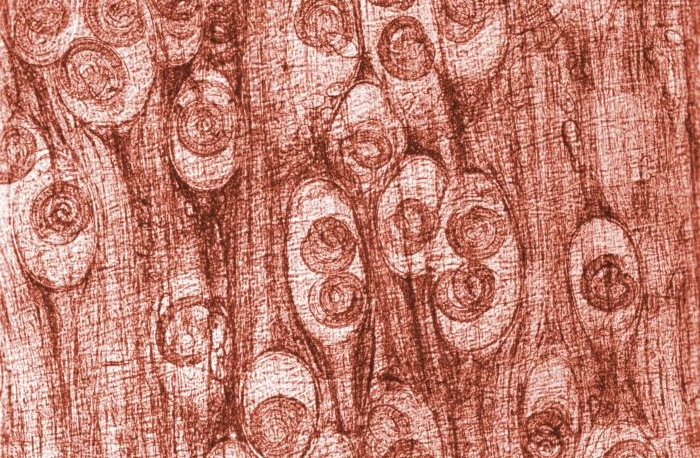This week’s NTD is a condition that is produced by a bacterium belonging to the same family of microbes that cause leprosy and tuberculosis. Buruli ulcer is an infection caused by Mycobacterium ulcerans, which releases a toxin in the body causing destruction of soft tissues and skin (1). As the toxin continues to be released, ulcers form on the surface of the skin, typically on the upper and lower extremities, and can become serious enough to cause long-term disability (1).
Initial signs of disease include the formation of nodules and painless swelling of the legs, arms and face (1). Within four weeks of infection, if untreated, the classic ulcers associated with the disease will form (1). The ulcers can extend down to the level of the bone, causing severe disability and typically do not take a specific shape—they can be rugged and asymmetrical or more rounded depending on the individual infection. There are three categories of ulcer formation: category I, being a single small lesion making up 32% of cases; category II, having non-ulcerative and ulcerative plaque formation making up 35% of cases; and, category III, extending into bones and joints making up 33% of cases (1). For 80% of category I infections, a course of antibiotic medications is required. However, as severity of infection increases there is an increased risk of needing surgery to remove dead tissue and to correct deformities caused by the ulcers (2, 3).
Buruli ulcer is found in at least 33 countries globally, located primarily in countries surrounding the equator in Africa (4). Côte d’Ivoire, Democratic Republic of the Congo and Ghana report the most cases each year, with more than 1,000 reported cases a year, however, in recent years, Australia has reported an increasingly larger number of cases (4). In May 2018, health officials from Victoria, Australia reported an increase in Buruli ulcer infections since 2015, but there is no certain cause for this increase (5). In 2017, there were 275 reported cases in Victoria, compared to 182 cases in 2016 (5). In 2018, there were 28 cases as of May 4, as compared to 31 cases at the same time in 2017 (5). Everyone is susceptible to infection, however, those in endemic regions are at a higher risk of contracting the bacteria (5). Furthermore, the age of infection varies across all affected regions. In Australia, 10% of all cases are in children under the age of 15, whereas in Africa, 48% of cases are under the age of 15 (4). Of the 33 countries that have reported cases of Buruli ulcers, only 15 report statistics to the World Health Organization (WHO) (2). Between 2002 and 2015, there were over 55,000 cases identified among the reporting countries (2).
A key reason it is difficult to control Buruli ulcer is because the transmission of disease is still unknown (6). It is not believed to be contagious and there is no proven link between humans and animals with the bacterium, though it hypothesized that insects in water may transmit the bacteria to humans (6). Horses, dogs, alpacas, koalas and opossums are all known to carry the bacteria based on laboratory tests conducted in Victoria, Australia (6). Without knowing how people get infected, it is very difficult to prevent infection, so most work focuses on identifying and treating the disease instead.
The current WHO strategy for the control and research of Buruli ulcer is “to minimize the morbidity, disability and socio-economic burden” by focusing on early detection and antibiotic treatments (7). Four key activities are used in this plan: community-level, including early case detection and community education; strengthening of the health system; standardized case management, including standardized laboratory confirmation, antibiotic regimen and wound care; and supportive activities, including advocacy, research and monitoring the control activities (7).
Buruli ulcer is a notable member of the neglected tropical disease family. Its stomach-churning lesions and painful swelling are only amplified due to the lack of knowledge surrounding its transmission and need for high doses of antibiotics. The next step is critical: researching the disease more in order to understand its mode of transmission. Without this knowledge, there is no way to effectively prevent disease, and work towards its elimination.
Sources:
[1] http://www.who.int/buruli/disease/en/
[2] http://www.who.int/buruli/en/
[3] https://www.cdc.gov/buruli-ulcer/treatment.html
[4] http://www.who.int/buruli/epidemiology/en/
[5] http://outbreaknewstoday.com/australia-increased-reports-buruli-ulcer-victoria-82690/
[6] https://www.cdc.gov/buruli-ulcer/transmission.html
[7] http://www.who.int/buruli/control/en/

